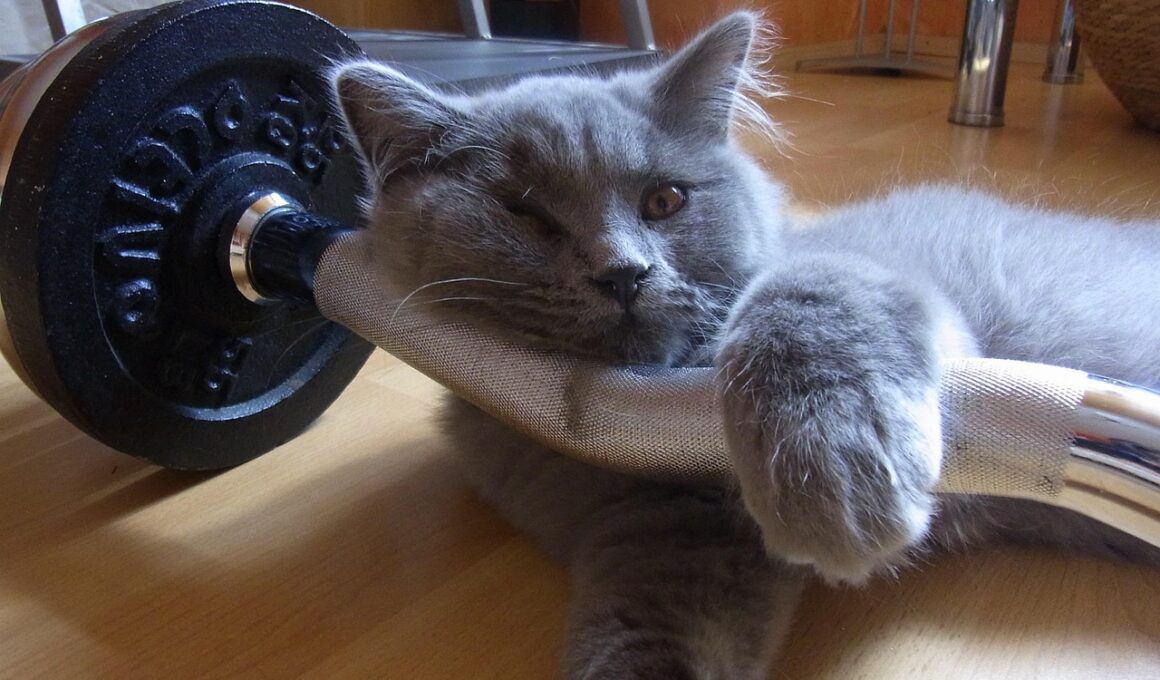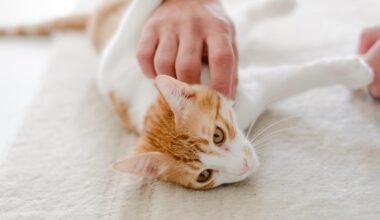Top Tips for Redirecting Aggressive Cat Behavior
Training your cat to stop biting and scratching can be challenging. Aggression in cats often stems from fear, stress, or insufficient playtime. Understanding the root cause of aggressive behavior is essential. Cats may bite or scratch when feeling threatened or overstimulated. Therefore, you must identify your cat’s triggers, which can help redirect these behaviors more positively. You can observe when your cat is likely to act aggressively and adjust your approach accordingly. For instance, if your cat bites during play, ensure the play sessions include breaks. By providing your feline with alternative ways to express their energy, you can prevent problematic behavior. Additionally, create a safe and cozy environment that minimizes stressors. Hands-on interaction should occur when the cat is relaxed, which reduces the chances of them reacting aggressively. Furthermore, regular veterinary check-ups help ensure your cat is physically healthy and doesn’t experience pain leading to aggressive behaviors. A healthy balance of play, rest, and social interactions makes all the difference in their temperament. This balance can foster a happier and healthier environment for both you and your cat.
Positive reinforcement plays a vital role in modifying your cat’s aggressive behavior. Reward your feline with treats or praise when they display calm and gentle behavior. This technique reinforces the good behavior you wish to see more of in the future. A clicker can also be useful in this context, as it provides a clear and immediate marker for when they perform desirable actions. Establish a routine that helps your cat feel secure and less anxious, reducing the likelihood of aggression. When engaging with your cat, ensure it is on their terms. Avoid forcing affection, which may lead to biting or scratching. For instance, gently tease your feline with a toy, allowing them to exhibit their predatory skills without using your hands. This strategy can redirect their aggression towards something appropriate. Moreover, invest in interactive toys that challenge them mentally and physically. Toys like feather wands and laser pointers encourage healthy play, which can reduce stress and anxiety. By substituting aggression with play, you not only keep your cat engaged but also strengthen your bond as you interact in a positive manner during those playful moments.
Another vital approach is providing adequate outlets for their energy. Cats are inherently playful creatures that require stimulation. A lack of play can lead to pent-up energy manifesting as aggressive behavior. Designate play sessions daily that last at least 15-20 minutes. Incorporating both individual playtime and interactive sessions can provide variety. For solo play, consider automated laser toys or balls that can engage your cat on their own. Remember to rotate their toys regularly to prevent boredom, keeping their interest piqued. During interactive play, observe their body language to identify when they become overexcited. If you notice signs of overstimulation, like dilated pupils or erratic movements, it’s best to pause the play. Establishing boundaries around play is essential; teaching them when to stop is not just about physical safety but also emotional well-being. Redirect them to a toy or scratching post if they start showing signs of aggression. Addressing your child’s instinctual need to hunt while keeping play sessions consistent fosters a happier feline. These tactics can prove foundational in transforming the aggressive cat into a well-rounded, playful companion.
Understanding Feline Body Language
Your cat’s body language plays a significant role in understanding their emotional state. By learning how to read these physical cues, you can act preemptively to prevent aggressive behavior. For instance, a cat’s tail position reveals much about their mood. An upright tail signifies a happy and confident cat, while a puffed-up tail indicates fear or aggression. Also, observe the ears. Ears flattened against the head usually mean that your cat feels threatened. Familiarizing yourself with these signals enables you to respond positively before aggression arises. If your cat’s body language reveals stress or agitation, provide them with a safe space to retreat to. Encouraging your cat to express their feelings fosters trust and security. Regular handling during their relaxed moments also helps your cat acclimate to touch. Cats that are accustomed to being handled are less likely to react defensively when stroked in a sudden situation. Creating an environment for proper socialization with other animals can also help develop positive behaviors. Understanding these nuances can be critical when addressing a cat’s aggressive tendencies.
Mistakes often made by cat owners include using harsh discipline or punishing aggressive behavior. Cats do not respond well to negative reinforcement; it can lead to increased anxiety and fear. Instead, focus on redirecting aggressive tendencies with more positive methods. When your cat displays aggressive tendencies, try to move away calmly or redirect their attention. Getting angry or raising your voice may only exacerbate fear or defensiveness. Instead, acknowledge the behavior without giving it attention. If you notice that they react aggressively during certain interactions, it’s crucial to adapt your approach. Instead of forcing affection, let your cat come to you when they feel comfortable. Make an effort to engage with them during their calm moments by using toys instead of your hands. If they exhibit biting or scratching during play, pause to indicate that this behavior is not acceptable. Allow them to observe that aggression halts the fun. By creating a clear distinction between acceptable and unacceptable behaviors, your cat will be less likely to act out. Thus, through patience and consistent reinforcement, you can help them understand.
Implementing a Consistent Training Routine
Having a consistent training routine further supports your cat’s behavioral improvements. Establish daily sessions focused on redirecting aggression, lasting around 5-10 minutes. Consistency is key in reinforcing positive behaviors, so aim to train them during similar times each day. If your cat shows signs of aggression, try to redirect their attention immediately to something enjoyable instead. Slowly introduce short training sessions that involve using treats, encouraging your cat to engage with you rather than bite or scratch. This technique transforms training into a bonding experience. Gradually increase the complexity of tasks as they learn, rewarding them with treats and affection to keep them motivated. With time, they will associate positive experiences with training, strengthening your relationship. In stressful situations, you can calmly guide them away from aggression by redirecting their attention elsewhere. Consistent reinforcement, frequent rewards, and positive interactions will promote overall emotional stability. It’s essential that you remain patient, as training a cat takes time and persistence. Pay attention to their progress, and don’t hesitate to change your approach if your initial methods don’t seem effective.
Finally, if the aggression continues despite your best efforts, consider seeking professional help. A certified animal behaviorist or a veterinarian specializing in feline behavior can provide tailored advice specific to your cat. In some cases, aggression may stem from underlying health issues; addressing these can improve your cat’s behavior. Always ensure your feline receives regular health check-ups to rule out medical causes triggering aggression. There may be underlying pain or discomfort responsible for their aggressive responses. Furthermore, professionals can help build a comprehensive training plan addressing behavioral issues. By collaborating with experts, you will empower yourself with tools to create a holistic approach to redirecting aggression effectively. Remember that every cat is unique, and what works for one may not work for another. With dedicated effort, patience, and possibly professional support, you can help your cat feel safe and secure. The ultimate goal is to create a loving environment where both you and your cat flourish together. Multiple avenues lead to achieving a peaceful coexistence; explore them to see what fits your situation best.
In conclusion, redirecting aggressive cat behavior requires time and dedication. Recognizing the causes and triggers of aggression plays a vital role in effectively managing it. Utilizing positive reinforcement, consistent routines, and understanding feline body language is crucial in transforming your cat’s behavior. Always prioritize building trust and ensuring your cat feels secure in their environment. Remember that patience is essential, and expected changes may take time. As you implement various strategies and remain adaptable in your approach, you will eventually create a more harmonious relationship with your feline friend. While training may seem daunting initially, commitment to the process can yield countless rewards. The journey becomes easier as you improve your cat’s emotional state and cultivate a more peaceful living space together. The way you react and engage with your cat paves the path for a positive relationship. Focus on the small wins and celebrate progress along the way. With time and perseverance, redirecting aggression is completely achievable. Ultimately, your cat flourishes when they feel safe, loved, and understood, and your shared bond will only grow stronger through mutual respect and affection.


